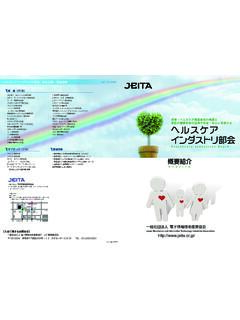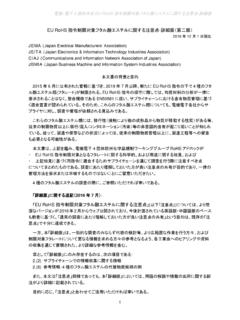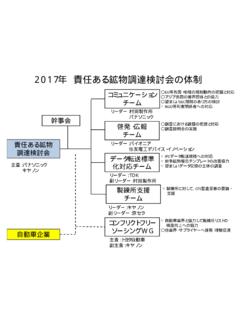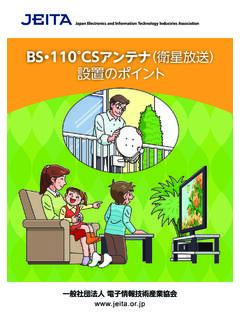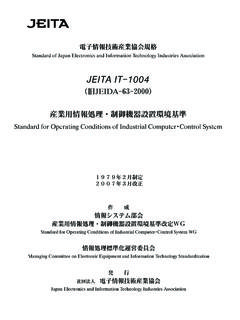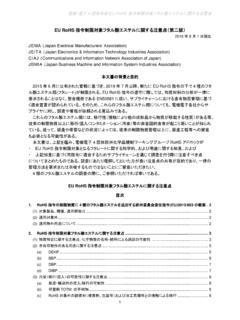Transcription of 橡 ED-4701 1 开䔀开⸀倀䐀 - JEITA
1 Standard of Japan Electronics and Information Technology Industries AssociationEIAJ ED-4701 /100 Environmental and endurance test methods forsemiconductor devices(Life test I)Established in August, 2001 Prepared byTechnical Standardization Committee on Semiconductor DevicesPublished byJapan Electronics and Information Technology Industries Association11, Kanda Surugadai 3-chome, Chiyoda-ku, Tokyo 101-0062, JapanPrinted in JapanTranslation without guarantee in the event of any doubt arising, the original standard in Japanese isto be standards are established independently to any existing patents on the products, materials orprocesses they assumes absolutely no responsibility toward parties applying these standards or toward patent owners. 2001 by the Japan Electronics and Information Technology Industries AssociationAll rights reserved. No part of this standards may be reproduced in any form or by any meanswithout prior permission in writing from the ED-4701 /100 CONTENTSPage1.
2 DEFINITION OF TEST METHOD 101 STEADY STATE OPERATING METHOD 102 TEMPERATURE HUMIDITY BIAS (THB)..15 TEST METHOD 103 TEMPERATURE HUMIDITY METHOD 104 MOISTURE SOAKING AND SOLDERINGHEAT STRESS SERIES METHOD 105 TEMPERATURE METHOD 106 INTERMITTENT OPERATING ED-4701 /100 Standard of Japan Electronics and Information Technology Industries AssociationEnvironmental and endurance test methods for semiconductor devices(Life test I) standards provide for environmental test methods and endurance test methods (especially lifetests) aimed at evaluating the resistance and the endurance of discrete semiconductor devices andintegrated circuits (hereinafter generically called semiconductor devices) used in electronicequipment mainly for general industrial applications and consumer applications, under the variousenvironmental conditions of various kinds that occur during their use, storage and OF TERMSThe definitions of the technical terms used in these standards and in the relevant specifications aregiven in EIAJ ED-4701 /001 "Environmental and endurance test methods for semiconductor devices(General).
3 " precautions used in these standards and in the relevant specifications are given in EIAJ ED-4701 /001 "Environmental and endurance test methods for semiconductor devices (General)." METHODSR efer to the Appendix for the test :The various test methods are arranged independently for the sake of more convenient use of ED-4701 OF ESTABLISHMENT OF THESE STANDARDSB efore the establishment of these standards, the standardization referring to EIAJ ED-4701 "Environmental and endurance test methods for semiconductor devices" established on Feb., 1992,and EIAJ has issued amendments, whenever the revision and also new test method , it is recondite where the latest test methods are entered, it was resulting the confusion ofusers. So establishment of new numbering system that is easy to use both users and manufacturerswas decided, and reached to the issuance in this Industries Association of Japan (EIAJ) and The Japan Electronic Industry DevelopmentAssociation (JEIDA) have merged effective November 1,2000, the Japan Electronics and InformationTechnology Industries Association ( JEITA ).
4 OF THE DELIBERATIONSThe revision of the standards and new numbering system have been deliberated by "Sub-Committeeon Semiconductor Devices Reliability" of the Technical Standardization Committee onSemiconductor Devices/Semiconductor Devices Reliability Group from Apr., 2000. Though to issueas a separate standard every each test method was considered, it made to issue with the system likethe following.(a)EIAJ ED-4701 /001 Environmental and endurance test methods for semiconductor devices(General)(b)EIAJ ED-4701 /100 Environmental and endurance test methods for semiconductor devices(Life test I)101 Steady state operating life102 Temperature humidity bias (THB)103 Temperature humidity storage104 Moisture soaking and soldering heat stress series test105 Temperature cycle106 Intermittent operating life(c)EIAJ ED-4701 /200 Environmental and endurance test methods for semiconductor devices(Life test II)201 High temperature storage202 Low temperature storage203 Moisture resistance (Cyclic)204 Salt mist(d)EIAJ ED-4701 /300 Environmental and endurance test methods for semiconductor devices(Stress test I)301 Resistance to soldering heat for surface mounting devices (SMD)302 Resistance to soldering heat (excluding surface mounting devices)
5 303 Solderability304 Human body model electrostatic discharge (HBM/ESD)EIAJ ED-4701 /100305 Charged device model electrostatic discharge (CDM/ESD)306 Latch-up307 Thermal shock (e)EIAJ ED-4701 /400 Environmental and endurance test methods for semiconductor devices(Stress test II)401 Terminal strength402 Mounting strength403 Vibration (Sinusoidal)404 Shock405 Acceleration (Steady state)(f)EIAJ ED-4701 /500 Environmental and endurance test methods for semiconductor devices(Miscellaneous)501 Permanence of marking502 Flammability tests of plastic-encapsulated devices (Externally induced)503 Seal504 Low air pressureBoth life and stress tests are divided into two standards as "I" and "II". "I" is including test methodthat is thought that revision occurs comparatively from now MEMBERSD eliberation of this standard has been made by "Sub-Committee on Semiconductor DevicesReliability" of the Technical Standardization Committee on Semiconductor Devices/SemiconductorDevices Reliability are listed the members of deliberation of this standard.
6 <Technical Standardization Committee on Semiconductor Devices/Semiconductor DevicesReliability Group>ChairmanMitsutoshi ItoNEC Corp.<Semiconductor Devices Reliability Group>ChairmanKazutoshi MiyamotoMitsubishi Electric Corp.<Sub-Committee on Semiconductor Devices Reliability>ChairmanTetsuaki WadaMatsushita Electronics Co., ChairmanMasaki TanakaHitachi YoshidaOki Electric Industry Co., NakayamaKawasaki Microelectronics, KunitaSanken Electric Co., KatouSanyo Electric Co., KawayoshiSharp KanayamaShindengen Electric Mfg. Co., MannenNew Japan Radio Co., ED-4701 /100 Hiroyoshi OdairaSeiko Epson NatsumeSony MatsuuraToshiba IgarashiIBM Japan, SadaikeTexas Instruments Japan OmoriNEC YamaguchiFujitsu YasudaFuji Electric Co., MitsuhashiMitsubishi Electric KusudaMitsumi Electric Co., OharaRicoh Co., ItoRohm Co., MembersYasuhiro FukudaOki Electric Industry Co.
7 , ObinataSony WatanabeNEC ED-4701 /100 APPENDIXEIAJ ED-4701 /100 TEST METHOD 101 STEADY STATE OPERATING standard provides for the method to evaluate the endurance of semiconductor devices when theyare submitted to electric stress and thermal stress of long :Care must be taken when executing this test, because the device temperature may exceed the ambientpreset temperature and rise conspicuously due to internally dissipated heat from the EQUIPMENTE quipment to be used in this test should consist of a chamber capable to keep the specified testtemperature within the specified tolerance, the power supply capable to generate the specified AC orDC voltages, and the board to make electrical contact to the terminals of devices under test withsocket or other mounting method, having biasing and operating schemes shall consider the limitations of the device.
8 Device thermalcharacterization shall be considered to ensure that the temperature of "Hot Spots" on the die does notexceed maximum rated junction temperature (Tjmax). mountingDevice mounting shall consider the thermal capacity to minimize adverse effects during :When he SMD is mounted on the test board for evaluation, the relevant conditions (substrate material,land size, soldering method, flux cleaning, etc.) should be specified in the relevant chamberThe environmental chamber shall be capable of maintaining the specified ambient temperature withina tolerance of 5 C throughout the chamber while a test is being measurementThe initial measurements should be carried out in conformity with the items and conditions specifiedin relevant mode and test circuitOperating mode and test circuit should be in conformity with the stipulations of the relevantspecifications.
9 (1)High-Temperature Operating Life (HTOL)The HTOL test is configured to exercise the maximum number of nodes feasible. The supplyvoltages and clock frequency should be in conformity with the stipulations of the relevantspecifications.(2)High-Temperatu re Reverse-Bias (HTRB)The HTRB test is configured to apply the maximum rated DC reverse voltage (VRMAX) to thedevices that remain in a static mode of operation for the duration of the test. The supply voltageEIAJ ED-4701 /100should be in conformity with the stipulations of the relevant specifications.(3)High-Temperature Forward-Bias (HTFB)The HTFB test is configured to apply power to the device samples so as to forward bias majorpower-handling junctions. The devices are operated in either a static or pulsed operating condition should be conformity with the stipulations of the relevant HTFB test is typically used for diodes, transistors or power driver integrated temperatureThe ambient temperature should be 125 C 5 C, unless otherwise exceeded the maximum ratedjunction temperature (Tjmax).
10 Remarks:Care must be taken because the maximum rated junction temperature (Tjmax) may be exceeded due tointernally dissipated heat from the durationThe test duration should be 1000 hours (+168 hours, -0 hours), unless otherwise specified. If interimmeasurements are deemed necessary, they may be chosen from the following standard time intervals,as time to perform such hours(+ 8 hours, - 0 hours)48 hours(+ 8 hours, -0 hours)96 hours(+24 hours, -0 hours)168 hours(+72 hours, -0 hours)504 hours(+168 hours,-0 hours)Remarks:The time spent reducing chamber conditions to room ambient and conducting the interimmeasurements shall not be considered a portion of the total specified test treatmentAt the end of the test period, the specimen should be stored under normal conditions from 2 hours to24 measurementThe end-point measurements should be carried out in conformity with the items and conditionsspecified in the relevant.


